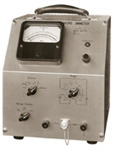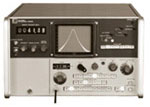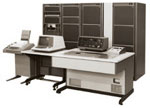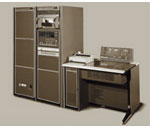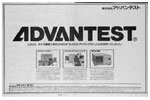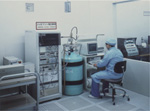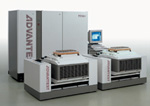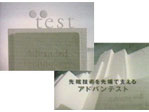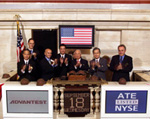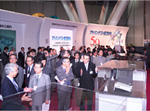| 1990 |
- The company establishes Advantest Taiwan, Inc. in Hsinchu, Taiwan.
- The company becomes the world's first private firm to install and operate a Josephson Voltage Standard System for precise metrological calibration.
|
| 1991 |
- The company ranks first in American research firm VLSI research's 1990 Customer Satisfaction Survey of semiconductor manufacturing equipment users.
|
| 1992 |
- The company adopts the profit center approach and cash flow management.
- Enters the LCD test market with the launch of the industry's highest-resolution LCD driver test systems, the G4350 (for R&D) and the G4310 (for volume production).
|
| 1993 |
- The company announces the "Advantest Charter on the Global Environment."
- "Advantest Beijing Technical Seminars '93," an event introducing the company's products and technology, held in Beijing to mark the company's formal entrance into the Chinese market.
- The T6691, a VLSI test system featuring an industry-best test speed of 500MHz/1GHz, is launched.
- The U4941-a portable RF spectrum analyzer for field maintenance use-is launched, and becomes the company's first product to win a design award from the Ministry of International Trade and Industry (now the Ministry of Economy, Trade, and Industry).
|
| 1994 |
- By organizing functions as module blocks, the company develops a compact, light base station analyzer for digital mobile communications infrastructure use, the R3465.
|
| 1995 |
- 250MHz S-DRAM memory test system T5581 launched; become a best-selling product.
- The company adopts a merit-based group-wide objective personnel management / evaluation system.
- First company website unveiled.
|
| 1996 |
- The company opens a new R&D center in Gunma Prefecture, designated the Advantest Group's worldwide R&D hub.
- The T6671B VLSI test system-delivering a 4x smaller footprint and 80% lower test cost than its predecessor product-wins the Minister of Trade and Industry Award at the Machine Design Awards sponsored by the Nikkan Kogyo Shimbun.
- The company launches sales of the F5120, a high-throughput electron beam lithography tool capable of etching patterns on silicon wafers at the 0.18μm scale-expanding its field of operations to include front-end semiconductor manufacturing processes.
|
| 1997 |
- The company establishes an EB Lithography Division, signaling its commitment to the business.
- Launches the high-end, high-accuracy T5591 memory test system, featuring a test speed of 500MHz / 1GHz, and the T6682 LSI test system, with industry-best performance metrics of 1GHz test speed and a maximum 1,024 pins.
- The R3131 low-cost, low-end spectrum analyzer, designed to meet market needs, is launched and becomes another hit product.
- The Nikkei Shimbun ranks Advantest first in its "Nikkei Ranking of Excellent Companies."
|
| 1998 |
- The company airs its first TV commercial during the Nagano Olympics.
- Launches a flicker analysis system to contribute to the safety of animated television programs.
- Ranked first, for the second year running, in the Nikkei Shimbun's "Nikkei Ranking of Excellent Companies." Advantest is rated highly for the scale of its operations and its profitability and stable growth outlook.
|
| 1999 |
- The company establishes the Advantest Code of Conduct, an ethics manual for employees.
- Introduces performance-linked bonuses, based on cash flow.
- Launches the T6672, an industry-best LSI test system delivering improvements in footprint, affordability, and throughput over its predecessor the T6671, developed in 1995.
- Announces a lineup of solutions targeting the WDM market, anchored by the best-in-class Q7750 optoscope and the Q8384 optical spectrum analyzer.
|
